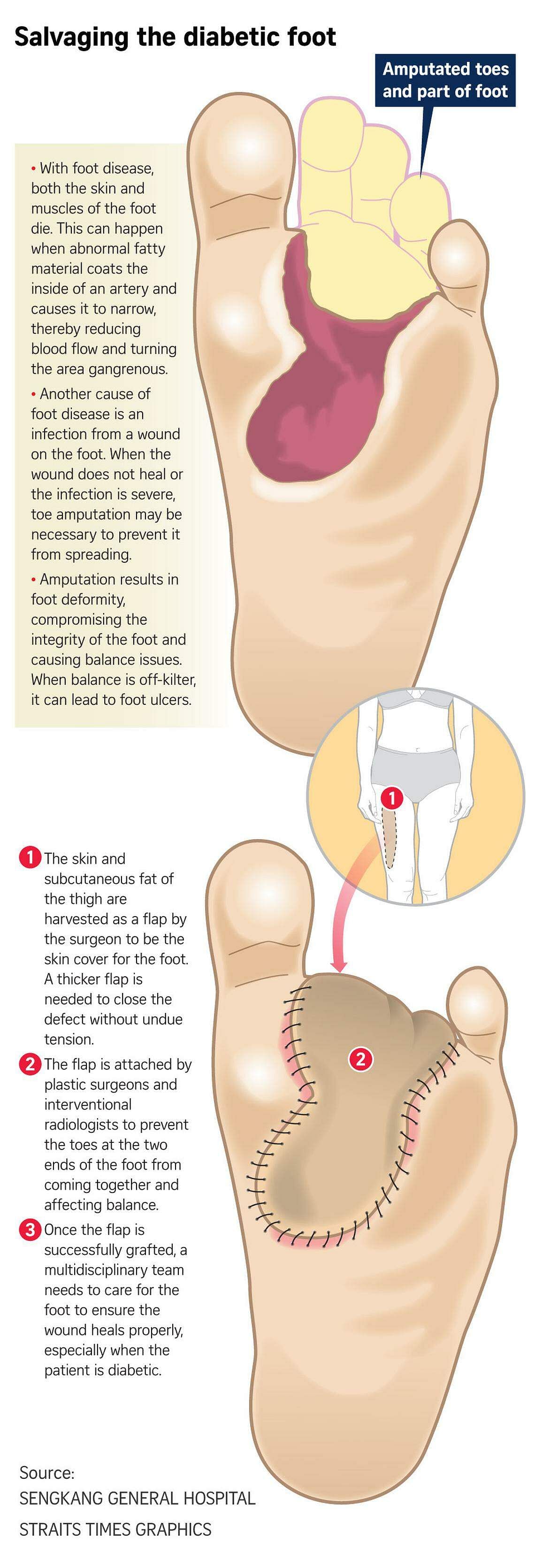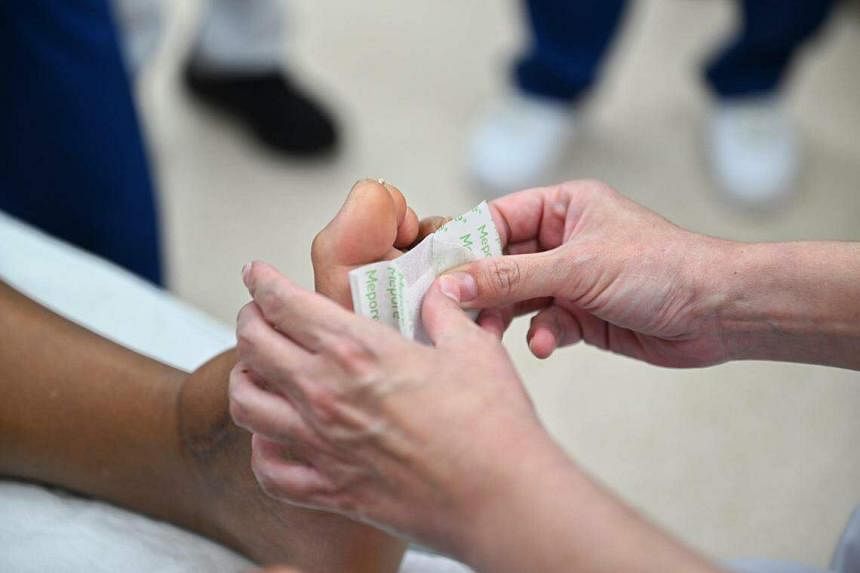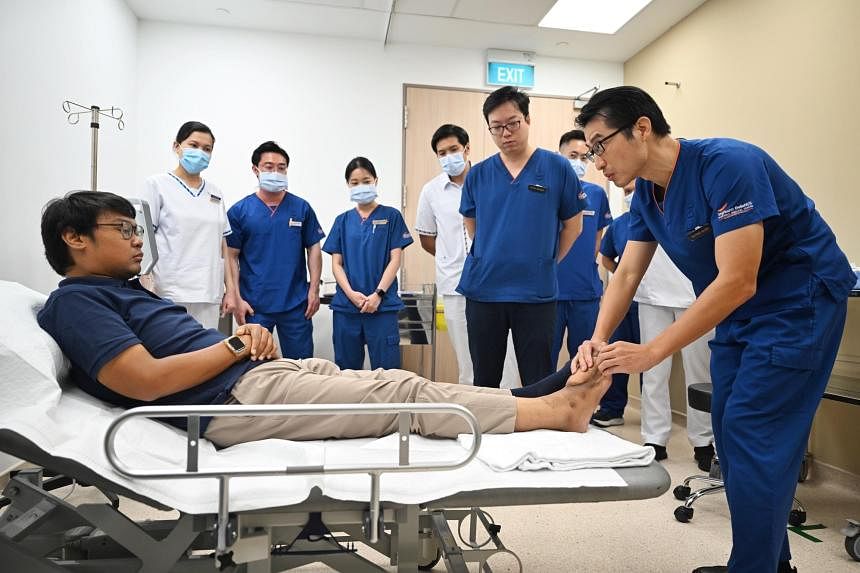SINGAPORE – More than one in 10 people with diabetes who develop complications that lead to amputation are below the age of 50, a statistic that is borne out among the diabetic patients seen at Sengkang General Hospital (SKH).
“At SKH, we see younger diabetic patients, many of whom are sole breadwinners for their families, develop complications. Should they undergo an amputation, their family’s livelihood will be affected,” said orthopaedic surgeon Francis Wong.
He said the hospital’s studies have shown that patients with diabetic foot infections are mostly from a lower socioeconomic status and usually lead sedentary lives.
“Their control of their diabetes is bad,” he added.
To ensure diabetic patients, especially those who are still in their productive ages and have lost some of their toes, are able to heal and walk more or less normally, Dr Wong assembled some colleagues from different specialities to manage them as a multidisciplinary team.
Comprising orthopaedic surgeons, interventional radiologists, plastic surgeons, podiatrists, physiotherapists, dietitians and nurses, the team aims to make sure patients are “shoe-able” enough to resume their lives and livelihoods.
This means the shape and integrity of the foot are maintained so that it is capable of bearing weight again, and the patient can stand and walk safely.
Diabetes is a serious health concern, with more than 400,000 Singaporeans living with the disease.
It is estimated that by 2050, a million Singapore adults will have diabetes.
The lifetime risk of developing diabetes is one in three, and statistics have shown that more than a third of those with diabetes will develop a foot ulcer in their lifetime.
Diabetic foot infections often result in amputation of the affected toes.
Healing can take a long time, and is often not adequate, exacting a mental and financial toll on patients.
“Amputation results in foot deformity, compromising the integrity of the foot and resulting in balance issues. This can lead to other foot ulcers,” Dr Wong said.
“We want these patients to return to the community independently, but… because the foot is now deformed, the normal pressure of the foot is gone. The patient will walk poorly in shoes, resulting in very poor quality of life.”

To strengthen the foot to compensate for the missing toes, orthopaedic and plastic surgeons and interventional radiologists work to create a flap using the lateral muscle and skin from the thigh that is grafted to the part of the foot without toes, said Dr Wong.
“Once the flap is successfully grafted, other members of the team – the podiatrists, physiotherapists and nurses – will work with the doctors to manage the foot and ensure the wound heals properly, especially when the patient is diabetic,” he added.
Other public hospitals in Singapore also have programmes for diabetic patients, and their focus is on saving as much of the leg as possible.
The Rapid Access Foot clinic at Singapore General Hospital works with the emergency department and polyclinics, as well as a network of primary care general practitioners, to allow same-day referral of patients with diabetic foot ulcers, enabling these high-risk patients to receive timely treatment and to avoid hospital admission.
At National University Hospital, vascular surgeons play the leading role in the overall management of diabetic foot disease patients with peripheral arterial disease.
They offer prompt restoration of blood supply to the foot and toe region (either using minimally invasive endovascular therapy or open surgery bypass) and antibiotic therapy for infection control, as well as aggressive wound and non-viable tissue management (including wound debridement, minor toe amputation and forefoot amputation).
Customer service and facilities manager Muhammad Sufian Rahim, 33, and senior activity supervisor at the Singapore Association for Mental Health Zuriah Rasman, 40, both patients of SKH, were able to retain their ability to walk after having their toes removed. Both are breadwinners for their families.

“I work and take care of my father, who has end-stage heart failure, my mother, who suffers from hypertension, my husband, who has colorectal cancer, and two young children. So I put aside caring for myself as my family came first,” Madam Zuriah said.
When she developed a sore on her foot, she ignored it and continued working until she developed a fever from the ensuing infection.
“I was told by the hospital that my last toe could not be saved,” she said.
After surgeons removed her toes and created a flap to retain the integrity of her foot, Madam Zuriah now wears specially designed shoes to protect the flap and help with her balance “because of my large size”, she said.
“I used to say family first. Now, I realise that if I love my family and want to take care of them, I have to take care of myself first,” Madam Zuriah said.
Mr Sufian, who was diagnosed with diabetes when he was in his early 20s, stepped on glass shards in December 2022. His foot became swollen and badly infected – “a result of my uncontrolled diabetes”, he said.
“When I was told I needed to have one of my toes removed, I was worried and scared. I was the sole breadwinner then, supporting my father and younger sister. I asked myself, if my toe was amputated, would I be able to walk? Would I be able to work? Would it affect our livelihood?” he said.
Mr Sufian lost not only his toe, but also his job because he had to go in and out of hospital.
“With the help of the podiatrists and physiotherapists, I was able to walk a month after my (flap) surgery. I am now able to wear normal shoes again,” he said.
After regaining his ability to walk normally, Mr Sufian found a new job.
He has totally cut sugar out of his life and exercises cautiously so that he does not put pressure on his feet.
Mr Sufian says any time he feels like consuming sugar or not exercising, all he has to do is to look down.
“My nine toes are a constant reminder. The fact that I have only nine will never go away,” he said, laughing.
Correction note: This article has been edited for accuracy.


